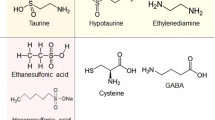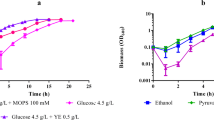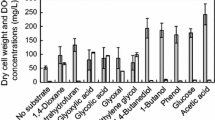Abstract
The hexadecane degradation of Acinetobacter oleivorans DR1 was evaluated with changes in temperature and ionic salt contents. Hexadecane degradation of strain DR1 was reduced markedly by the presence of sodium chloride (but not potassium chloride). High temperature (37°C) was also shown to inhibit the motility, biofilm formation, and hexadecane biodégradation. The biofilm formation of strain DR1 on the oil-water interface might prove to be a critical physiological feature for the degradation of hexadecane. The positive relationship between biofilm formation and hexadecane degradation could be observed at 30° C, but not at low temperatures (25°C). Alterations in cell hydrophobicity and EPS production by temperature and salts were not correlated with biofilm formation and hexadecane degradation. Our proteomic analyses have demonstrated that metabolic changes through the glyoxylate pathway are important for efficient degradation of hexadecane. Proteins involved in fatty acid metabolism, gluconeogenesis, and oxidative stress defense proteins appear to be highly expressed during biodégradation of hexadecane. These results suggested that biofilm formation and oxidative stress defense are important physiological responses for hexadecane degradation along with metabolic switch to glyoxylate pathway in strain DR1.
Similar content being viewed by others
References
Ali, A., J.A. Johnson, A.A. Franco, D.J. Metzger, T.D. Connell, J.G. Morris, and S. Sozhamannan. 2000. Mutations in the extracellular protein secretion pathway genes (eps) interfere with rugose polysaccharide production in and motility of Vibrio cholera. Infect. Immun. 68, 1967–1974.
Baldi, F., N. Ivosevic, A. Minacci, M. Pepi, R. Fani, V. Svetlicic, and V. Zutic. 1999. Adhesion of Acinetobacter venetianus to diesel fuel droplets studied with in situ electrochemical and molecular probes. Appl. Environ. Microbiol. 65, 2041–2048.
Bergogne-Berezin, E. and K.J. Towner. 1996. Acinetobacter spp. as nosocomial pathogens: microbiological, clinical, and epidemiological features. Clin. Microbiol. Rev. 9, 148–165.
Ionescu, M. and S. Belkin. 2009. Overproduction of exopolysaccharides by an Escherichia coli K-12 rpoS mutant in response to osmotic stress. Appl. Environ. Microbiol. 75, 483–492.
Jung, J. and W. Park. 2010. Complete genome sequence of the diesel-degrading Acinetobacter sp. strain DR1. J. Bacteriol. 192, 4794–4795.
Kang, Y.S., J. Jung, C.O. Jeon, and W. Park. 2010. Acinetobacter oleivorans sp. nov. is capable of adhering to and growing on dieseloil. J. Microbiol. In Press
Kang, Y.S. and W. Park. 2010a. Protection against diesel oil toxicity by sodium chloride-induced exopolysaccharides in Acinetobacter sp. strain DR1. J. Biosci. Bioeng. 109, 118–123.
Kang, Y.S. and W. Park. 2010b. Contribution of quorum-sensing system to hexadecane degradation and biofilm formation in Acinetobacter sp. strain DR1. J. Appl. Microbiol. 109, 1650–1659.
Kang, Y.S. and W. Park. 2010c. Trade-off between antibiotic resistance and biological fitness in Acinetobacter sp. strain DR1. Environ. Microbiol. 12, 1304–1318.
Lee, Y., Y. Kim, S. Yeom, S. Kim, S. Park, C.O. Jeon, and W. Park. 2008. The role of disulfide bond isomerase A (DsbA) of Escherichia coli O157: H7 in biofilm formation and virulence. FEMS Microbiol. Lett. 278, 213–222.
Onbasli, D. and B. Aslim. 2009. Effects of some organic pollutants on the exopolysaccharides (EPSs) produced by some Pseudomonas spp. strains. J. Hazard Mater. 168, 64–67.
O’Toole, G.A. and R. Kolter. 2006. Flagellar and twitching motility are necessary for Pseudomonas aeruginosa biofilm development. Mol. Microbiol. 30, 295–304.
Pompilio, A., R. Piccolomini, C. Picciani, D. D’Antonio, V. Savini, and G. Di Bonaventura. 2008. Factors associated with adherence to and biofilm formation on polystyrene by Stenotrophomonas maltophilia: the role of cell surface hydrophobicity and motility. FEMS Microbiol. Lett. 287, 41–47.
Rosenberg, M., E.A. Bayer, J. Delarea, and E. Rosenberg. 1982. Role of thin fimbriae in adherence and growth of Acinetobacter calcoaceticus RAG-1 on hexadecane. Appl. Environ. Microbiol. 44, 929–937.
Rosenberg, M., D. Gutnick, and E. Rosenberg. 1980. Adherence of bacteria to hydrocarbons: a simple method for measuring cell-surface hydrophobicity. FEMS Microbiol. Lett. 9, 29–33.
Sabirova, J.S., M. Ferrer, D. Regenhardt, K.N. Timmis, and P.N. Golyshin. 2006. Proteomic insights into metabolic adaptations in Alcanivorax borkumensis induced by alkane utilization. J. Bacteriol. 188, 3763–3773.
Schneiker, S., V.A.P. Martin dos Santos, D. Bartels, T. Bekel, M. Brecht, J. Buhrmester, T.N. Chernikova, and et al. 2006. Genome sequence of the ubiquitous hydrocarbon-degrading marine bacterium Alcanivorax borkumensis. Nat. Biotechnol. 24, 997–1004.
Stanier, R.Y., N.J. Palleroni, and M. Doudoroff. 1966. The aerobic pseudomonads: a taxonomic study. J. Gen. Microbiol. 43, 159–271.
Sutherland, I. 2001. The biofilm matrix an immobilized but dynamic microbial environment. Trends Microbiol. 9, 222–227.
Tomaras, A.P., C.W. Dorsey, R.E. Edelmann, and L.A. Actis. 2003. Attachment to and biofilm formation on abiotic surfaces by Acinetobacter baumannii: involvement of a novel chaperone-usher pili assembly system. Microbiology 149, 3473–3484.
Vallenet, D., P. Nordmann, V. Barbe, L. Poirel, S. Mangenot, E. Bataille, C. Dossat, and et al. 2008. Comparative analysis of Acinetobacters: three genomes for three lifestyles. PLoS One 3, e1805.
van Loosdrecht, M.C., W. Norde, and A.J. Zehnder. 1990. Physical chemical description of bacterial adhesion. J. Biomater. Appl. 5, 91–106.
Watanabe, K., Y. Kodama, and S. Harayama. 2001. Design and evaluation of PCR primers to amplify bacterial 16S ribosomal DNA fragments used for community fingerprinting. J. Microbiol. Methods 44, 253–262.
Author information
Authors and Affiliations
Corresponding author
Rights and permissions
About this article
Cite this article
Jung, J., Noh, J. & Park, W. Physiological and metabolic responses for hexadecane degradation in Acinetobacter oleivorans DR1. J Microbiol. 49, 208–215 (2011). https://doi.org/10.1007/s12275-011-0395-8
Received:
Accepted:
Published:
Issue Date:
DOI: https://doi.org/10.1007/s12275-011-0395-8




